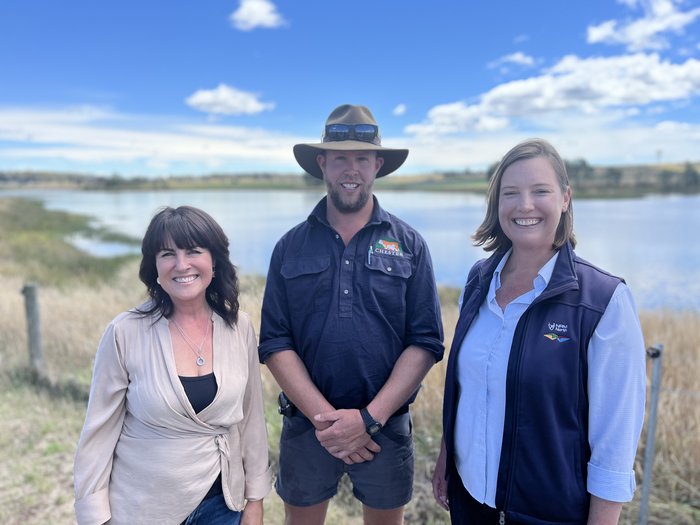Collaborative efforts supporting waterway health
19 January 2024

Minister Jo Palmer, landholder Sam Archer and NRM North CEO Dr Jo Fearman
For the past four years, northern Tasmanians have joined forces to tackle the challenge of removing pathogens from local waterways, resulting in significant improvements to the health of the kanamaluka / Tamar estuary.
This collaboration of efforts, known as the Tamar Estuary River Health Action Plan - Catchment Works Program, has brought together farmers, environmental scientists, engineers, community organisations, and everyday citizens.
NRM North Chief Executive Officer Dr Jo Fearman said the program, which is an initiative of the Tamar Estuary Management Taskforce, has facilitated 184 projects through Tamar Action Grants supporting 150 landholders to install livestock-exclusion fencing along waterways and improve dairy effluent management.
“While there is still a year of project activities to be completed, the Catchment Works Program had already demonstrated the power of collaboration in addressing environmental challenges and promoting sustainable practices,” Dr Fearman said.
“Keeping livestock out of waterways in the catchment has significant water quality benefits that carry into the estuary and contributes to the overall work of the Taskforce in improving river health. Installing fences also protects the riparian zone which provides significant ecological functions as well as habitat and biodiversity benefits.”
To 31 December 2023, the Tamar Action Grants have assisted landholders across the Meander, North Esk, South Esk, Brumbys-Lake, Macquarie and Tamar catchments to achieve:
- 2,667 ha of improved milking platform on dairy farms
- 84.1 km of stock exclusion fencing on dairy farms
- 464 km of stock exclusion fencing on grazing properties
- 2,322 ha of riparian area protected for regeneration
- 120 ha of revegetation contracted
The other major element of the Catchment Works Program, the Sewage Intrusion Project, has prevented an estimated 13.5 million litres of untreated sewage from entering the estuary annually.
Dr Fearman said the primary focus of the kanamaluka/ Tamar Estuary River Health Action Plan - Catchment Works Program is to reduce the median enterococci bacteria concentration in Zone 1 of the estuary, the area from Launceston to Legana.
“Monitoring of enterococci bacteria are used as an indicator of the potential presence of disease-causing pathogens, which are typically introduced into water supplies through faecal contamination,” Dr Fearman said.
“Catchment modelling from March 2022 has already shown a 7.3 per cent reduction in median enterococci bacteria concentrations for Zone 1, far more than the 4.7 per cent target.”
NRM North Water Program Manager Jesse Webster said the works have also led to significant secondary benefits.
“Removing stock from a waterway allows the riparian vegetation to regenerate, which reduces bank erosion and increases resilience to flood events,” Mr Webster said.
“Healthy native riparian vegetation plays a crucial role in a well-functioning ecosystem, offering numerous environmental benefits including reduced nutrients entering the river. High nutrient levels in waterways can lead to excessive algal growth and a decrease in dissolved oxygen, which are both harmful to fish.”
The 2022 modelling shows a reduction of nutrient and sediment concentrations in Zone 1 of the kanamaluka / Tamar estuary as:
- 4 per cent reduction in median Total Nitrogen concentrations
- 4.2 per cent reduction in median Total Phosphorus concentration; and
- 8 per cent reduction in median Total Suspended Solids concentration
NRM North continues to work closely with the Tamar Estuary Management Taskforce and other key stakeholders, including participating landholders, to improve water quality and deliver on the Taskforce’s vision and implementation plan for the kanamaluka / Tamar Estuary.
This program is supported with funding from the Tasmanian and Australian Governments through the Launceston City Deal ‘working together for healthy waterways’.